- Details
- Category: Turkey
- Published: Sunday, 16 May 2021 18:19
- Written by Greg
3rd Time's the Charm - Desert Turkey
During one of several scouting trips for turkeys, I found an out-of-the-way solitary canyon that, from what I could tell, held a single tom. This area about one mile in length apparently had just enough habitat to keep a few turkeys isolated to this quiet desert location. Several hundred yards below this particular spot, the terrain transitioned from pinyon pines to a seemingly endless sagebrush flat that stretched on for miles. Traveling the other direction, the pinyons quickly gave way to a dry rocky mountain covered by cedar trees and sage.
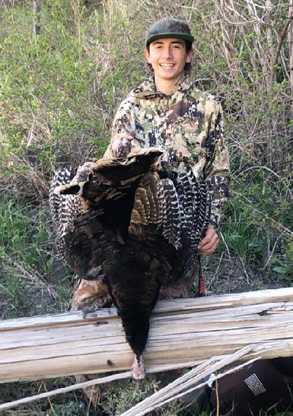
Different hunt but Carson called in and bagged his 1st turkey solo
Had I not stumbled upon some turkey droppings while hiking in this area, I never would have believed that turkeys inhabited this arid place. So at the sight of the droppings, I broke out my box call and started hammering away. And much to my surprise, my calls was answered by a lone gobble a couple hundred yards down off the hillside. I made my way to an opening and spotted the gobbler strutting in a small clearing. That single gobble and subsequent visual caused my son and me to come chase that gobbler on three separate occasions.
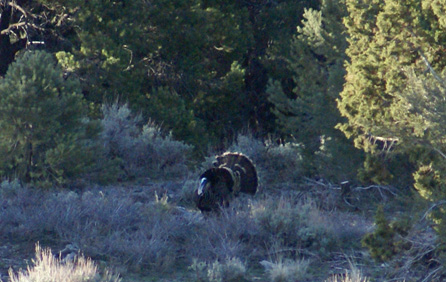
The lone 'strutter' I found while scouting
During our first outing we never saw the tom, but we did hear him gobble a few times in response to our calls. As patient as we were on that hunt, he just wouldn’t come close. Our reaction to his inaction was to move toward him, but that scheme didn’t work. Every time we attempted to close in, he’d quickly move off.
On our second trip we tried a different tactic, which almost worked. As soon as we heard the very first gobble, Carson hurried off to circle up around the turkey as I remained in place attempting to keep the tom gobbling. Carson was successful in getting to within 40 yards once, but the turkey remained tucked in behind a pinyon pine before finally slipping away without providing a shot.
On the final hunt for the elusive gobbler, I went solo. I arrived in the early evening and I placed a single hen decoy near the spot where Carson had seen the tom during our previous outing. Using my box call I let out several yelps but all was quiet. After about twenty minutes of silence, I decided to venture up the canyon in order to circle onto the hillside above my decoy. An hour later I was opposite my starting location. I again broke out my box call but before my series of yelps had concluded, a thunderous gobble sounded off in response! I estimated that the tom was within 80 yards. Since past experience with this bird showed that he didn’t appear interested in coming into my calls, I decided to cautiously pursue him without additional calling. Ten minutes later I had, very slowly, navigated a mere 20 yards through the trees when a far off gobble signaled that the tom was bugging out. Needless to say, that was my only close encounter of the evening.

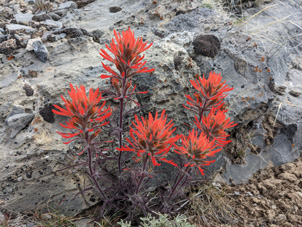
Couple of cool Western tanagers in the area Most of the terrain consists of sharp rocky outcroppings
The next morning I set up my decoy nearer to where I had the semi-close encounter the evening before. About thirty minutes before dawn, I was positioned close to my decoy, listening and hoping to hear a turkey calling from the roost. That didn’t happen. So about fifteen minutes before sunrise I let out a few calls hoping to hear a response, nothing. After twenty minutes of silence I decided to leave the spot to go call further up the canyon. I’d only gone a couple hundred yards when the gobbler responded to my call! I guessed he was within 200 yards so I ever-so-softly called as I approached. The tom continued to sound off at each of my calls -- this time my strategy seemed to be working! Now, less than 100 yards from the tom, I hunkered down and began producing soft chirps and purrs using my glass call. The tom continued to gobble! After thirty minutes or so of the back-and-forth calling, I could hear that the turkey was slowly closing the distance! Using my binoculars to peer through the thick brush and trees I finally spotted a red head about 45 yards away. The only problem was that I had several tree branches preventing any chance for a shot.
As I continued to watch the tom, his head suddenly dipped out of sight. I worried the tom was moving away for good, similar to his behavior on the past two outings. But realizing that a continued pursuit hadn’t worked in the past, especially given the noisy dry ground conditions, I remained in place and periodically eked out a soft call. Ten minutes later, the tom gobbled! Not only was he still close by, he had circled up around me into a slightly less obstructed area. You wouldn’t think binoculars would be a necessity when a turkey is lurking within 50 yards, but the dense cover made it tricky to locate the cagey gobbler. With my binos pressed tightly to my face, I finally spotted the tom when he stretched out his head from behind the brush to gobble! Cautiously I picked up my shotgun and leveled it in the direction of the turkey. All I needed was for the tom to step out from behind the thicket.
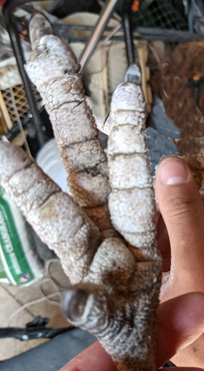
Not the best background for a pic, but crazy big calloused feet
Seconds seemed like minutes when at last -- the inquisitive blob emerged! His long protruding neck, capped by his big red head, searched longingly for the lonely hen who had been calling from my direction. Silently I slid the safety into the firing position and squeezed the trigger. At the blast the beating wings of the dead turkey kicked up dust and debris as it tumbled down the mountainside. In a mad dash I scrambled off the hill in quick pursuit. Once the tom finally came to rest, the first thing I noticed was the enormous size of the turkey’s feet. All I could figure was that the years of abuse from the rocky terrain had caused the gobbler’s feet to become heavily calloused. I was all smiles as I positioned my phone for a selfie with the mature tom that I had finally hoodwinked!
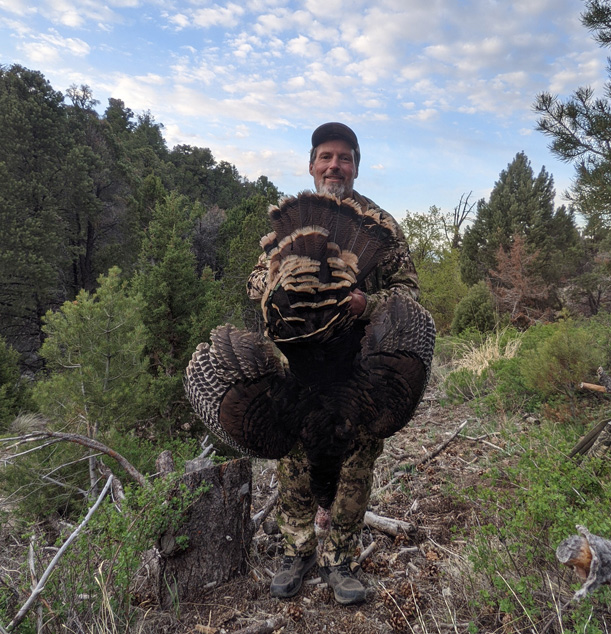
Spurs worn to nubs from rocky terrain, but still managed to keep 9 inches of beard
Conclusion - when hunting turkeys, here are some methods to consider:
- Patience - sometimes the key is to remain in place and wait for a tom to come to you. A gobbler may come running into your decoy spread or he may approach cautiously or he may follow approaching hens, but waiting him out may be the key to success.
- Pursuit – might be risky but pursuing a gobble may be your only hope for bagging a skittish gobbler. Be forewarned, a wary tom will often bust you before you get close enough for a shot.
- Ambush – putting yourself in the right place and waiting can work if you happen to know a turkey’s routine/pattern.
- Combination – if none of the above techniques work out, consider employing a combination of each.
- Persistence – keep at it, don’t give up!


